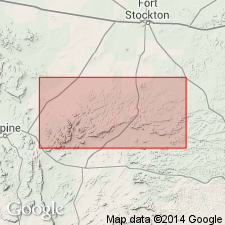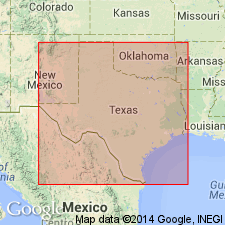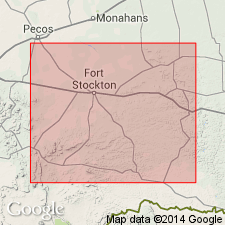
- Usage in publication:
-
- Nealranch formation
- Modifications:
-
- First used
- AAPG geologic province:
-
- Permian basin
Summary:
First used. Two formations, the Nealranch (base) and the Lenoxhills (top) first used in this report as replacements for Wolfcamp formation of Udden (1917) in Wolfcamp type locality (Wolf Camp Hills, Glass Mountains, Brewster Co, TX in Permian basin). Intent to name not stated, origin of name not stated, no type locality designated, and no lithologic description given for Nealranch. Thickness of this unit given as 300-470 ft. "Nealranch formation embraces the upper part of beds originally called Wolfcamp by Udden (1917) in the Wolf Camp Hills and is renamed to retain this widely used name for the time-stratigraphic unit, the Wolfcamp Series." Lenoxhills formation unconformably overlies the Nealranch, Gaptank, and older strata of the Marathon orogenic belt. Nealranch unconformably overlies the "grey limestone" of King (1930 and 1937) in the Wolf Camp Hills and contains the oldest SCHWAGERINA and PSEUDOSCHWAGERINA faunas thus far discovered in the Glass Mountains; the Pennsylvanian-Permian boundary is taken at this unconformity. Nealranch truncated and removed for some distance east of Wolf Camp Hills by pre-Lenoxhills erosion; Wolf Camp Hills, Gap Tank, the foot of Lenox Hills, and probably the base of Hess ranch horst are the only known outcrops of Nealranch in Glass Mountains. Is Permian (Wolfcamp) age. Composite stratigraphic section. Fossils drawn and discussed in detail.
Source: GNU records (USGS DDS-6; Denver GNULEX).

- Usage in publication:
-
- Neal Ranch Formation
- Modifications:
-
- Revised
- AAPG geologic province:
-
- Permian basin
Summary:
Neal Ranch Formation revised--lower contact changed. The "Gray Limestone" (bed no. 2 of King, 1938) is placed by the authors at base of Neal Ranch. This limestone was excluded from the Neal Ranch, as first used by Ross (1959); Ross placed it in the underlying Gaptank Formation. Neal Ranch consists of 412-547 ft (a revised composite section) of dark-gray shale alternating with thin or massive beds of limestone. Thins eastward. Underlies Wolfcampian (Lower Permian) Hess Conglomerate; overlies the lowermost Wolfcampian (Lower Permian) "UDDENITES-bearing Shale Member" (age modified) of Gaptank Formation (rest of Gaptank is Pennsylvanian). Neal Ranch is of early Wolfcamp age. Fossils discussed. Areal limits of "Gray Limestone" discussed in detail. Measured section.
Source: GNU records (USGS DDS-6; Denver GNULEX).

- Usage in publication:
-
- Neal Ranch Formation
- Modifications:
-
- Contact revised
- AAPG geologic province:
-
- Permian basin
Summary:
Upper contact revised in the Gap Tank area, Pecos Co, TX, Permian basin, in that conglomeratic rocks formerly assigned to the Hess Formation are reassigned to the newly named Stockton Gap Formation. Geologic maps. Cross section. Stratigraphic chart.
Source: GNU records (USGS DDS-6; Denver GNULEX).
For more information, please contact Nancy Stamm, Geologic Names Committee Secretary.
Asterisk (*) indicates published by U.S. Geological Survey authors.
"No current usage" (†) implies that a name has been abandoned or has fallen into disuse. Former usage and, if known, replacement name given in parentheses ( ).
Slash (/) indicates name conflicts with nomenclatural guidelines (CSN, 1933; ACSN, 1961, 1970; NACSN, 1983, 2005, 2021). May be explained within brackets ([ ]).

